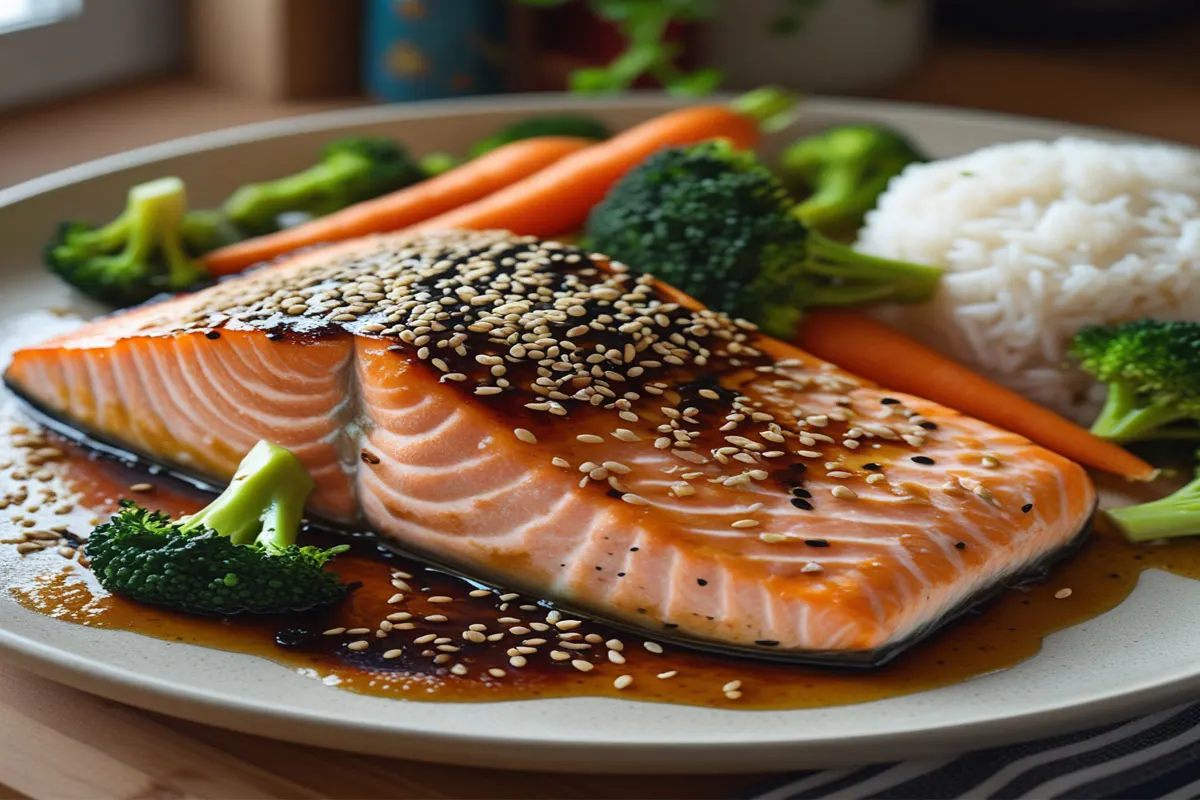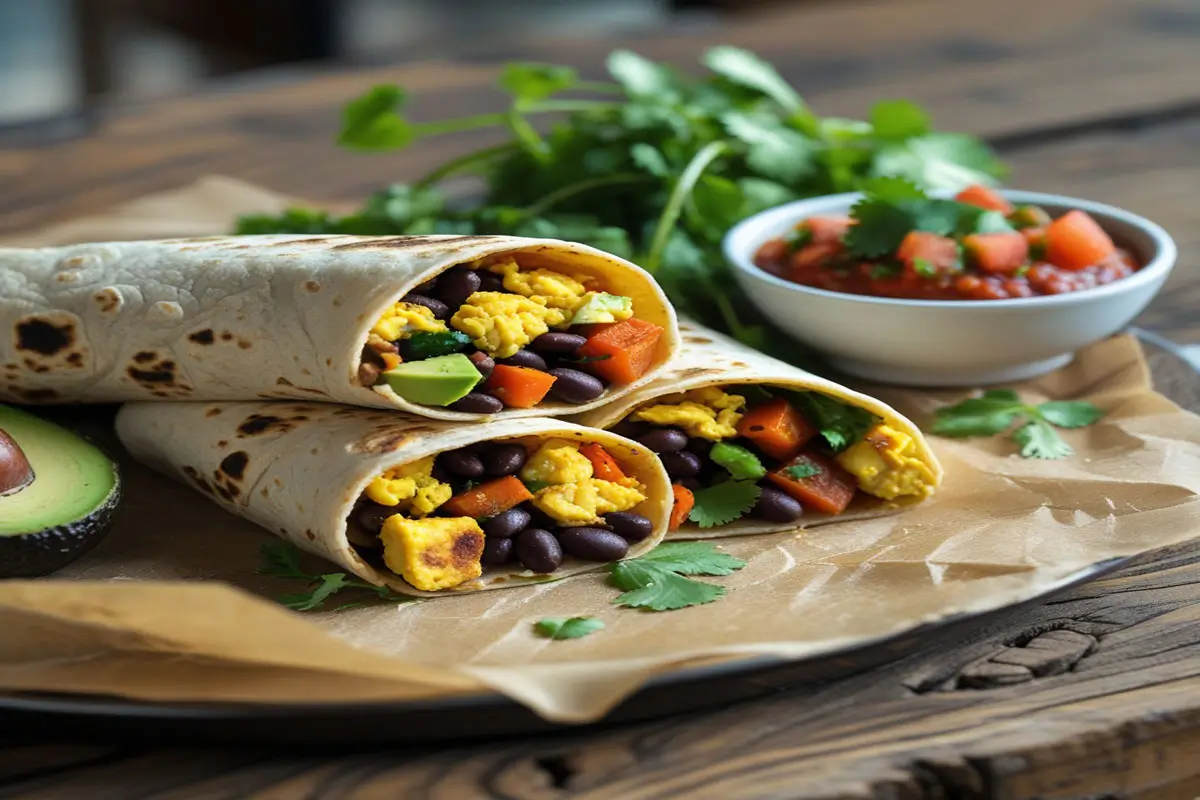Miso salmon is quickly becoming a favorite among seafood lovers due to its incredible flavor and health benefits. It’s not just a delicious meal but also a nutritious one that can be easily incorporated into your diet. Whether you’re an experienced cook or a beginner, learning how to prepare and cook miso salmon can be a simple and enjoyable experience. In this article, we will explore everything you need to know about miso salmon, from its health benefits to different cooking methods and variations. So, let’s dive in and discover why this dish is a perfect addition to your culinary repertoire.
Table of Contents
What is Miso Salmon?
Miso salmon is a delicious dish where salmon fillets are marinated in a miso-based sauce before cooking. The miso paste, made from fermented soybeans, gives the fish a rich umami flavor that enhances its natural taste. This meal can be prepared in various ways, such as grilling, baking, or pan-searing, making it versatile for different cooking styles.
To prepare this dish, the miso paste is mixed with ingredients like soy sauce, honey, garlic, and ginger to create a flavorful marinade. The fish absorbs the mixture, becoming tender and tasty. Whether you prefer a hint of sweetness or a bit of spice, this miso-glazed salmon can be customized to suit your preferences.
Health Benefits of Miso Salmon
Miso salmon not only delivers an explosion of flavor but also provides numerous health benefits. Here are the key advantages of adding this dish to your diet:
- Rich in Omega-3 Fatty Acids: Salmon is a fantastic source of omega-3 fatty acids, which play a crucial role in promoting heart health. These healthy fats help reduce inflammation, improve cholesterol levels, and support cognitive function.
- High in Protein: Packed with high-quality protein, salmon is an excellent choice for those looking to build or maintain muscle mass. It’s an essential component of a balanced diet for active individuals.
- Contains Antioxidants: Miso paste is loaded with antioxidants, particularly phytonutrients, which help combat oxidative stress in the body, thereby lowering the risk of chronic conditions and promoting overall wellness.
- Promotes Digestive Health: The fermentation process of miso introduces probiotics, which are beneficial bacteria essential for maintaining a healthy gut microbiome, supporting digestion and immune function.
Additionally, the marinade includes ginger and garlic, which have immune-boosting properties, and soy sauce adds rich umami flavor without contributing excessive calories or unhealthy fats. These combined elements make miso salmon not only a delicious choice but a nutritionally powerful one.lories. Consequently, miso salmon offers a well-rounded nutritional profile that can benefit your overall health.
How to Prepare Miso Salmon: Ingredients and Tools
Preparing miso salmon is relatively simple and requires only a few key ingredients and tools. Here’s what you’ll need:
Ingredients:
- 2 salmon fillets
- 2 tablespoons miso paste (white or red)
- 1 tablespoon soy sauce
- 1 tablespoon honey or maple syrup
- 1 teaspoon grated fresh ginger
- 1 garlic clove, minced
- 1 tablespoon rice vinegar
- Sesame seeds (optional, for garnish)
Tools:
- A mixing bowl
- A whisk or spoon for stirring
- A baking dish or a shallow dish for marinating
- Aluminum foil or parchment paper (if baking)
- A grill or stovetop pan for cooking
These simple ingredients and tools are all you need to create a flavorful miso salmon dish. Now, let’s move on to the cooking process.
Step-by-Step Guide to Cooking Miso Salmon
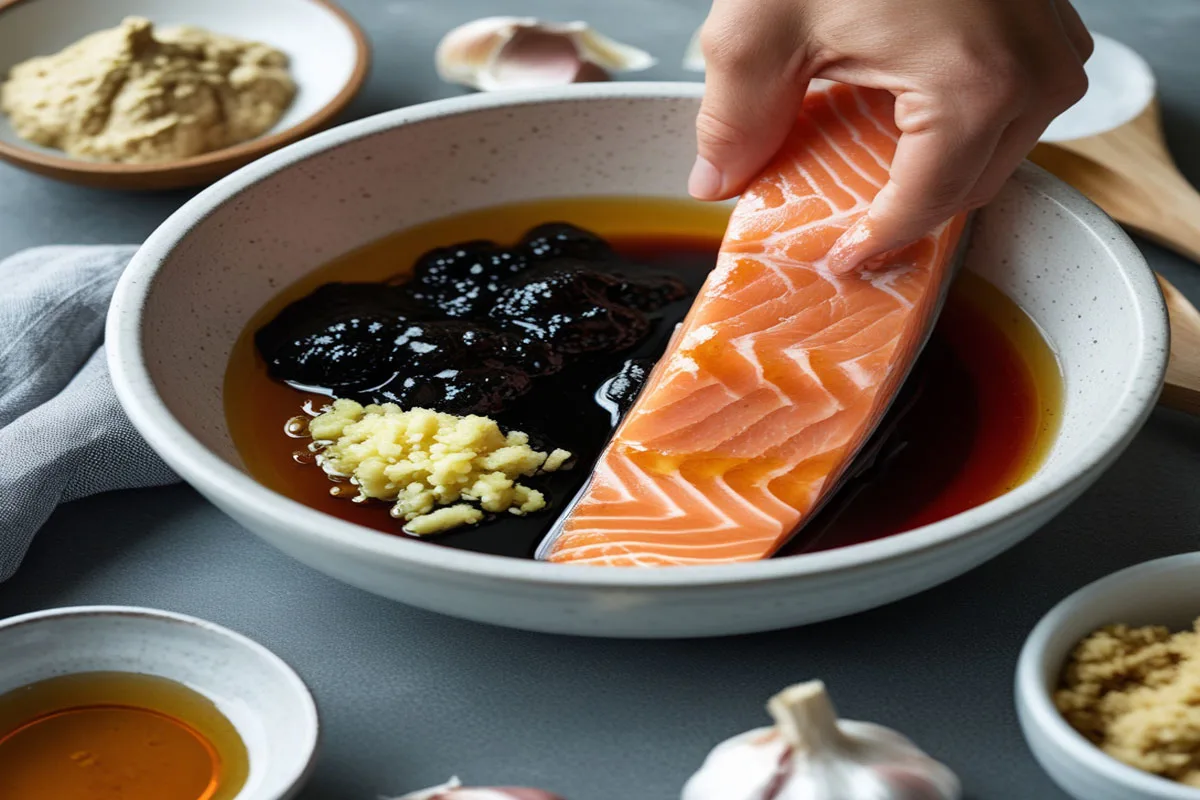
Now that you have your ingredients ready, follow these simple steps to cook perfect miso salmon.
Preparing the Miso Marinade
- Combine the Marinade Ingredients: In a mixing bowl, whisk together the miso paste, soy sauce, honey, grated ginger, minced garlic, and rice vinegar. This combination will create a thick and aromatic marinade.
- Marinate the Salmon: Place the salmon fillets in a shallow dish and pour the marinade over the fish. Make sure the fillets are well-coated. Allow the salmon to marinate in the refrigerator for at least 30 minutes to an hour, or up to overnight for a deeper flavor.
- Reserve Some Marinade: If you plan to serve the salmon with extra sauce, reserve a small portion of the marinade before adding it to the salmon. This ensures that the marinade doesn’t touch raw fish and remains safe for consumption.
Cooking the Salmon to Perfection
- Preheat the Oven or Grill: Preheat your oven to 375°F (190°C) if baking, or heat your grill or pan on medium-high heat if pan-searing or grilling.
- Cook the Salmon:
- If baking, place the salmon fillets on a baking sheet lined with parchment paper. Bake for about 12-15 minutes or until the fish flakes easily with a fork.
- If grilling or pan-searing, cook each side for 4-5 minutes, depending on the thickness of the fillets.
- Serve and Garnish: Once cooked, remove the salmon from the heat source and serve immediately. Garnish with sesame seeds or fresh herbs, if desired.
Different Variations of Miso Salmon Recipes
While the basic miso salmon recipe is flavorful on its own, there are many variations you can try to customize the dish. Here are a few ideas:
- Spicy Miso Salmon: Add a touch of chili paste or sriracha sauce to the marinade for a spicy kick. This variation pairs well with a cool cucumber salad.
- Miso Salmon with Vegetables: Roast or grill vegetables like broccoli, carrots, and bell peppers alongside the salmon. This creates a balanced meal with a variety of textures.
- Maple Miso Salmon: For a sweeter flavor, increase the amount of honey or use maple syrup in the marinade. The syrup enhances the miso’s natural sweetness, creating a delicious contrast.
- Miso Salmon Sushi Rolls: For a sushi twist, use miso-marinated salmon as the filling in sushi rolls. Add avocado, cucumber, and a dash of soy sauce for extra flavor.
These variations allow you to explore different tastes and textures, making miso salmon a versatile dish for any occasion.
Common Mistakes to Avoid When Cooking Miso Salmon
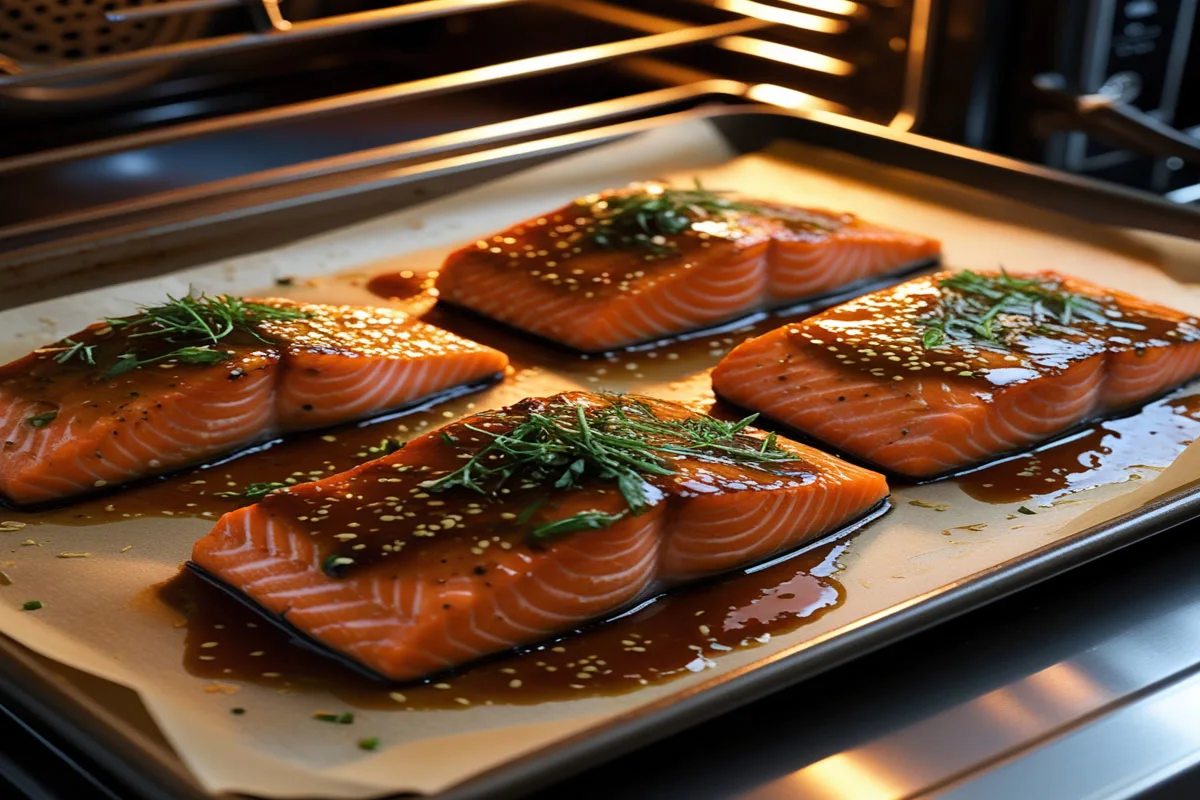
When preparing miso salmon, there are several common mistakes to avoid to ensure a successful outcome:
- Over-marinating the Salmon: While marinating is essential for flavor, marinating salmon for too long can lead to a mushy texture. Stick to the recommended time—usually 30 minutes to an hour.
- Using Too Much Miso Paste: Miso paste is quite potent, so it’s important not to overdo it. A little goes a long way in flavoring the fish.
- Overcooking the Salmon: Salmon can dry out quickly if overcooked. Keep an eye on the cooking time, and remove the fish as soon as it’s done. The fish should flake easily with a fork but still remain moist.
- Not Preheating the Cooking Surface: Whether baking or grilling, it’s essential to preheat your oven or grill. This helps the salmon cook evenly and prevents sticking.
Avoiding these mistakes will help you create a delicious miso salmon dish every time.
How to Serve Miso Salmon for a Balanced Meal
Miso salmon can be paired with various side dishes to create a well-rounded, nutritious meal. Here are some ideas to complement your dish:
- Steamed Rice: Serve the salmon with a side of fluffy steamed rice for a classic pairing. Brown rice or jasmine rice are great options for adding extra fiber.
- Sauteed Greens: Pair the salmon with sautéed vegetables like spinach, kale, or bok choy. These greens provide vitamins and minerals that complement the rich flavors of the fish.
- Fresh Salad: A light salad with ingredients like mixed greens, cucumber, and avocado can provide a refreshing contrast to the savory salmon.
- Roasted Potatoes: For a heartier meal, serve miso salmon with roasted potatoes or sweet potatoes. Their natural sweetness balances the umami flavor of the salmon.
These combinations ensure that your miso salmon meal is not only tasty but also nutritionally complete.
Storing and Reheating Leftover Miso Salmon
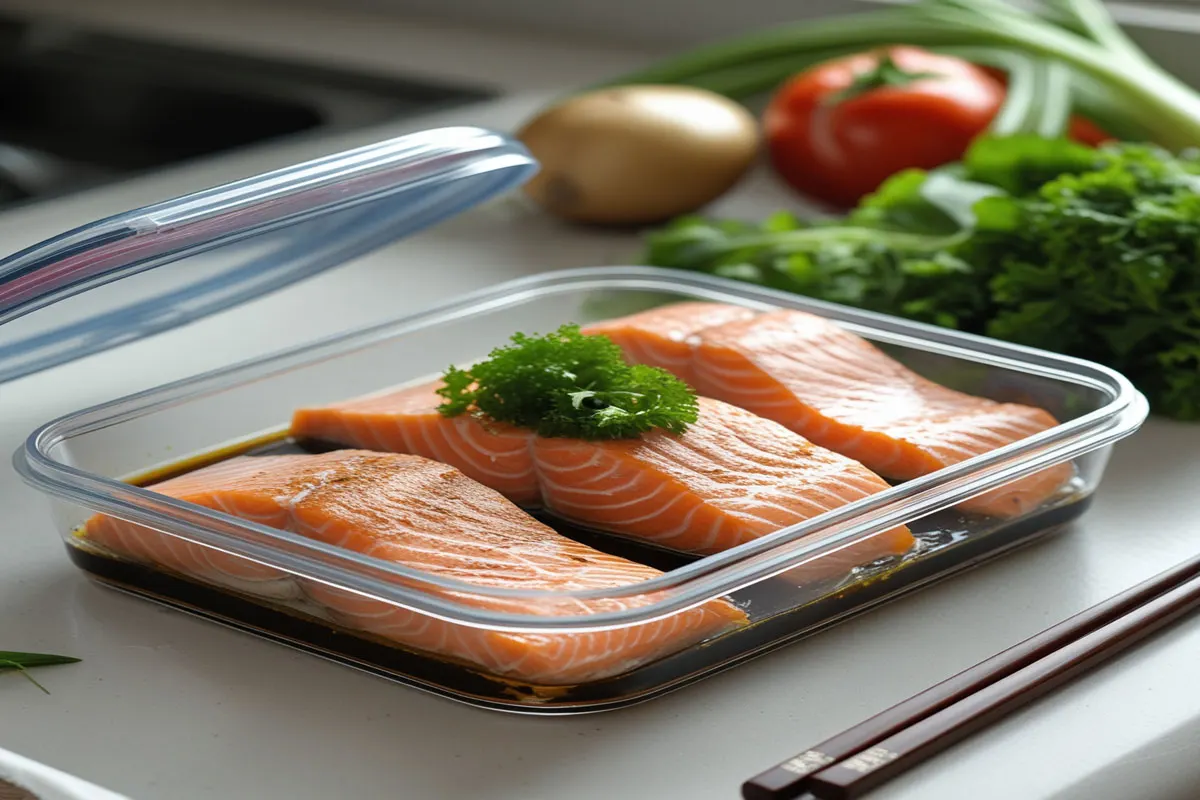
If you have leftover miso salmon, you can store and reheat it without losing flavor or texture. Follow these steps for the best results:
Proper Storage Methods for Fresh Miso Salmon
- Cool the Salmon: Let the salmon cool down to room temperature before storing it to avoid condensation in the container.
- Store in an Airtight Container: Place the leftover salmon in an airtight container to preserve its freshness. It can be stored in the refrigerator for up to 2-3 days.
- Freezing: If you need to store the salmon for a longer period, consider freezing it. Wrap the salmon tightly in plastic wrap and then aluminum foil. It can be frozen for up to 3 months.
How to Reheat Miso Salmon Without Drying It Out
- Use the Oven: Preheat your oven to 275°F (135°C). Place the salmon on a baking sheet, cover it with foil, and reheat for 10-12 minutes until warmed through. This method helps retain moisture.
- Stovetop Reheat: Place the salmon in a pan over low heat. Cover the pan with a lid and reheat for 3-5 minutes, flipping the salmon halfway through to ensure even heating.
- Microwave Reheat: If you’re in a hurry, you can microwave the salmon on a microwave-safe plate, covered loosely with a paper towel. Heat in 30-second intervals until warmed, but be careful not to overheat.
Discover how to make an authentic Old-Fashioned Pimento Cheese and enjoy the creamy richness with your favorite dishes. You can also try this Sour Cream Chicken Enchilada Casserole for a delicious twist.
FAQ:
Does Miso Work with Salmon?
Yes, miso works beautifully with salmon. The rich, umami flavor of miso complements the natural taste of the fish, creating a savory and satisfying dish. When salmon is marinated in miso paste, it absorbs the flavors, becoming tender and delicious. The balance of sweet, salty, and savory makes miso salmon a popular choice for many seafood lovers. Whether grilled, baked, or pan-seared, miso salmon is a versatile dish that pairs well with various sides.
What Are the 4 Ingredients in Miso Salmon?
The basic ingredients for making miso salmon include:
Salmon Fillets: The main protein in the dish, offering healthy omega-3 fats.
Miso Paste: Fermented soybean paste that provides a rich umami flavor.
Soy Sauce: Adds saltiness and enhances the miso flavor.
Honey or Maple Syrup: A touch of sweetness that balances the saltiness of the miso and soy sauce.
These four ingredients are the core of the miso salmon marinade, creating a deliciously savory dish.
Is Miso Salmon Healthy?
Yes, miso salmon is a healthy dish. Salmon is packed with omega-3 fatty acids, which are excellent for heart health, brain function, and reducing inflammation. Additionally, miso paste is rich in probiotics, which support digestive health. Combined with the protein in salmon, miso salmon provides a well-rounded meal that is nutrient-dense and beneficial for overall health. Just be mindful of portion sizes and avoid overuse of salty ingredients like soy sauce to keep it balanced.
What the Heck Is Miso?
Miso is a fermented paste made primarily from soybeans, salt, and a type of fungus called koji. This paste has been a staple in Japanese cuisine for centuries, often used to add a deep, savory flavor known as umami to various dishes. Depending on the type of miso, it can range from mild and sweet to rich and salty. The fermentation process not only gives miso its distinctive taste but also makes it a source of probiotics, beneficial for gut health.
Conclusion: Enjoying Miso Salmon in Your Regular Diet
Incorporating this flavorful fish into your regular diet is a great way to enjoy a meal that is both nutritious and satisfying. Rich in omega-3 fatty acids, protein, and antioxidants, miso salmon brings numerous health benefits to the table. By following simple preparation steps and exploring different variations, you can create meals that perfectly fit your preferences. Additionally, avoiding common cooking mistakes ensures that each time you make it, you’ll achieve delicious results. Whether you’re a beginner or seasoned chef, this dish is an excellent addition to your weekly meals. Enjoy preparing it and savoring the flavors of this healthy and tasty option!

